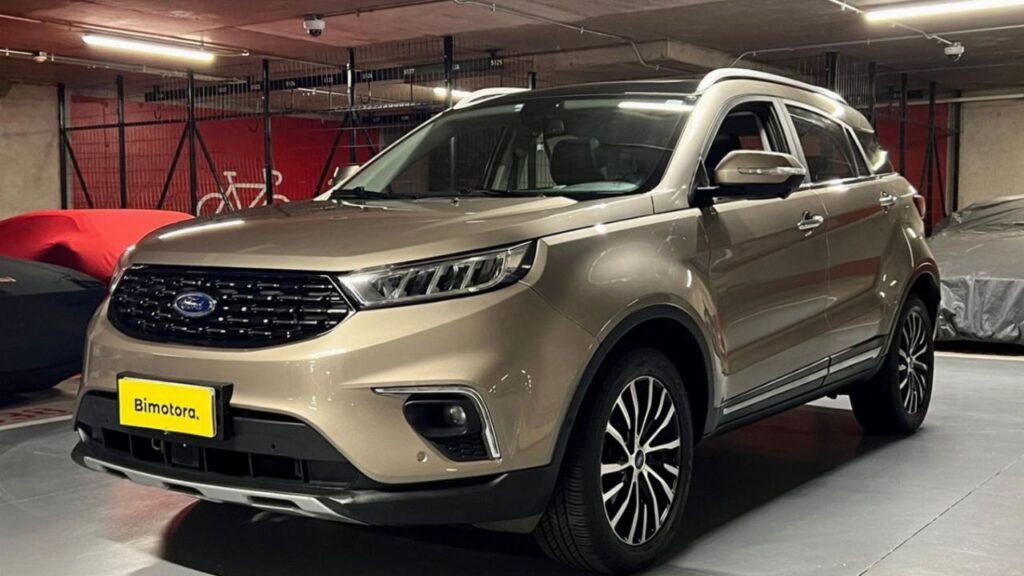The automotive world rarely witnesses the resurrection of discontinued nameplates, making Ford’s decision to revive the Territory badge particularly significant. After years of absence from Australian showrooms, the Territory returns as a modern SUV designed to compete directly with established players like the Toyota Prado.
This comeback story represents more than just another vehicle launch. Ford’s strategic revival of the Territory nameplate signals their renewed commitment to the Australian market and recognition of local brand loyalty.

Historical Context: Territory’s Original Legacy
The original Ford Territory carved out a unique position in the Australian SUV market from 2004 to 2016. Built locally in Melbourne, it combined Australian engineering with family-friendly practicality that resonated with local buyers.
Despite its eventual discontinuation, the Territory maintained a loyal following. Many owners appreciated its distinctive character and capabilities that differentiated it from imported alternatives.
Why Ford Chose to Revive Territory
Market research revealed strong residual affection for the Territory brand among Australian consumers. Ford recognized an opportunity to leverage this goodwill while addressing current SUV market demands.
The decision reflects Ford’s broader strategy to strengthen their presence in key global markets. Australia’s SUV segment growth makes it an attractive target for renewed investment and product development.
Evolution from Sedan Platform to Purpose-Built SUV
Unlike its predecessor, which shared components with the Falcon sedan, the new Territory sits on a dedicated SUV platform. This foundation provides superior structural integrity and allows for optimized interior packaging.
Modern safety requirements and consumer expectations necessitated this fundamental change. The new approach enables Ford to deliver contemporary features and performance standards expected in today’s competitive SUV landscape.
Design and Engineering Excellence
Ford’s design team faced the challenge of honoring the Territory’s heritage while creating a thoroughly modern vehicle. The result combines familiar Territory DNA with contemporary Ford global design language.
The exterior proportions suggest capability and strength without appearing overly aggressive or intimidating. Chrome accents and distinctive grille treatment provide premium visual appeal expected in this price segment.
Interior Architecture and Space Utilization
Seven-seat configuration comes standard, addressing one of the original Territory’s strongest selling points. The third row offers genuine adult accommodation rather than token children-only seating found in some competitors.
Premium materials throughout the cabin elevate the ownership experience. Soft-touch surfaces, quality trim pieces, and attention to detail demonstrate Ford’s commitment to competing with premium SUV brands.
Technology Integration and User Experience
The centerpiece of the Territory’s technology offering is Ford’s latest SYNC infotainment system. The large touchscreen display provides intuitive access to navigation, entertainment, and vehicle settings.
Wireless smartphone integration eliminates cable clutter while maintaining full connectivity. Multiple USB ports throughout the cabin ensure all passengers can keep devices charged during long journeys.
Powertrain Options and Performance
Ford offers multiple engine choices to suit different buyer preferences and budgets. The base engine provides adequate performance for family duties while maintaining reasonable fuel consumption figures.
Higher-specification variants feature more powerful engines that deliver confident acceleration and improved towing capabilities. All engines incorporate modern efficiency technologies to minimize fuel consumption and emissions.
Transmission and Drivetrain Sophistication
Advanced automatic transmissions across the range provide smooth power delivery and optimal gear selection. The transmission calibration prioritizes comfort during normal driving while offering responsive performance when required.
Available all-wheel-drive systems enhance traction and stability in challenging conditions. The system can automatically distribute power between front and rear wheels as needed, providing confidence in various weather and terrain conditions.
Towing Capabilities and Payload
The Territory’s towing capacity positions it competitively against the Toyota Prado and other established players. Maximum towing figures accommodate large caravans, boats, and trailers commonly used by Australian families.
Payload capacity allows for luggage, camping equipment, and other cargo without compromising passenger comfort. The combination of towing and carrying capability makes the Territory suitable for recreational activities and work applications.
Competitive Analysis: Territory vs. Toyota Prado
The Toyota Prado has dominated the seven-seat SUV segment for decades through proven reliability and strong resale values. However, the Prado’s age and conservative evolution create opportunities for more modern competitors like the Territory.
Pricing strategies will prove crucial in determining market success. Ford must balance competitive positioning with profitability while offering compelling value propositions to attract Prado buyers.
Feature and Equipment Comparison
Standard equipment levels reveal how Ford intends to differentiate the Territory from established competitors. Advanced safety systems, connectivity features, and comfort amenities come standard on entry-level variants.
The Prado’s reputation for reliability and durability sets a high benchmark for the Territory to match. Ford’s global warranty programs and service network must provide comparable peace of mind for potential buyers.
Off-Road Capability Assessment
While not designed as a hardcore off-road vehicle, the Territory offers sufficient capability for typical Australian recreational activities. Ground clearance, approach angles, and protection systems enable confident exploration beyond sealed roads.
The Prado maintains advantages in extreme off-road situations due to its truck-based construction and specialized systems. However, most buyers never fully exploit these capabilities, creating opportunities for the more car-like Territory.
Safety and Driver Assistance Technologies
Modern safety requirements demand comprehensive protection systems, and the Territory delivers advanced features across all trim levels. Autonomous emergency braking, blind spot monitoring, and lane keeping assistance provide active protection for occupants and other road users.
Five-star ANCAP safety ratings represent the minimum acceptable standard for family vehicles in this segment. Ford’s engineering team designed the Territory’s structure and safety systems to exceed these requirements.
Advanced Driver Assistance Systems
Adaptive cruise control with stop-and-go functionality reduces driver fatigue during long journeys. The system maintains safe following distances and can bring the vehicle to a complete stop in traffic situations.
Traffic sign recognition and speed limit alerts help drivers comply with changing road conditions. These systems work together to create a more relaxed and safer driving experience for Territory owners.
Passive Safety Features
The Territory’s body structure incorporates high-strength steel and advanced crumple zones to protect occupants in various collision scenarios. Multiple airbags provide comprehensive protection for all seating positions.
Child seat anchor points meet current safety standards and provide secure mounting for various child restraint systems. Ford’s engineers paid particular attention to rear-seat safety given the Territory’s family-focused positioning.
Market Positioning and Target Demographics
Ford positions the Territory to attract families upgrading from smaller SUVs or seeking alternatives to established seven-seaters. The target demographic includes households with multiple children who need genuine seven-seat capability.
Professional buyers who require towing capacity for work or recreational activities represent another key market segment. The Territory’s combination of comfort and capability appeals to tradspeople and recreational vehicle enthusiasts.
Urban vs. Regional Market Considerations
City-based buyers will appreciate the Territory’s maneuverability and parking ease compared to larger body-on-frame SUVs. The smooth ride quality and quiet cabin suit urban commuting and school run duties.
Regional buyers often prioritize durability and service accessibility over urban refinement. Ford’s expanding service network and parts availability must meet the expectations of customers in remote areas.
Fleet and Commercial Applications
Government fleets and commercial users represent significant volume opportunities for the Territory. Competitive pricing, strong warranty coverage, and local service support make it attractive for large-scale purchasers.
Family-friendly features also suit corporate executives and sales representatives who use vehicles for both business and personal purposes. The Territory’s professional appearance and practical capabilities serve dual-purpose requirements effectively.
Fuel Efficiency and Environmental Considerations
Modern engine technologies enable the Territory to achieve competitive fuel consumption figures despite its size and capability. Direct injection, turbocharging, and advanced transmission programming optimize efficiency across various driving conditions.
Real-world fuel consumption varies significantly based on driving patterns, load, and towing requirements. Ford provides comprehensive fuel economy data to help buyers understand expected running costs.
Alternative Powertrain Development
Hybrid variants may join the Territory lineup as Ford expands electrification across their global vehicle range. These systems could provide improved fuel economy while maintaining the towing and payload capabilities buyers expect.
Plug-in hybrid technology offers the potential for electric-only commuting with conventional engine backup for longer journeys. Such systems appeal to environmentally conscious buyers who aren’t ready for full electric vehicles.
Lifecycle Environmental Impact
Manufacturing processes increasingly incorporate sustainable practices and materials to reduce environmental impact. Ford’s global sustainability initiatives extend to Australian operations and local vehicle assembly.
End-of-life recycling programs ensure responsible disposal of vehicles and components. These initiatives address growing consumer awareness of environmental issues beyond operational emissions.
Service Network and Ownership Experience
Ford’s Australian service network provides comprehensive coverage across metropolitan and regional areas. Dealer locations, service intervals, and parts availability directly impact ownership satisfaction and long-term costs.
Training programs ensure technicians understand Territory-specific systems and procedures. Consistent service quality across the network builds customer confidence and supports strong resale values.
Warranty and After-Sales Support
Comprehensive warranty coverage protects buyers against unexpected repairs and builds confidence in Ford’s commitment to quality. Extended warranty options provide additional peace of mind for buyers planning long-term ownership.
Roadside assistance programs include emergency repairs, towing, and replacement vehicle services. These benefits add value to the ownership experience and differentiate Ford from competitors with limited support programs.
Parts Availability and Maintenance Costs
Competitive parts pricing and ready availability reduce long-term ownership costs. Ford’s global parts distribution network ensures reasonable lead times for both routine maintenance and accident repairs.
Service scheduling flexibility accommodates busy family schedules and business requirements. Extended service hours and mobile service options provide convenience for time-conscious Territory owners.
Future Development and Evolution

The Territory’s return represents the first step in Ford’s broader Australian market strategy. Success in this segment could encourage additional model introductions and increased local market investment.
Technology updates and mid-cycle refreshes will keep the Territory competitive throughout its lifecycle. Over-the-air updates enable new features and improvements without requiring dealership visits.
Autonomous Driving Technology Integration
Advanced driver assistance systems lay the groundwork for future autonomous capabilities. The Territory’s sensor arrays and computing power provide a foundation for enhanced automation as regulations and technology mature.
Vehicle-to-infrastructure communication could eventually enable coordinated traffic management and improved safety. These systems require significant infrastructure investment but offer long-term benefits for all road users.
Frequently Asked Questions
Q1: When will the Ford Falcon Territory SUV be available in Australia?
The Ford Falcon Territory SUV is expected to launch in mid-2025, with pre-orders potentially opening earlier in the year.
Q2: How does the Territory’s towing capacity compare to the Toyota Prado?
The Territory is expected to offer competitive towing capacity up to 3,000kg, matching or exceeding the Toyota Prado’s capabilities in most configurations.
Q3: Will the Territory be built in Australia?
No, the new Territory will be imported from Ford’s global manufacturing facilities, unlike the original locally-built model that ended production in 2016.
Also Read: GAC Aion V Electric SUV Joins Australia’s EV Market in 2025

